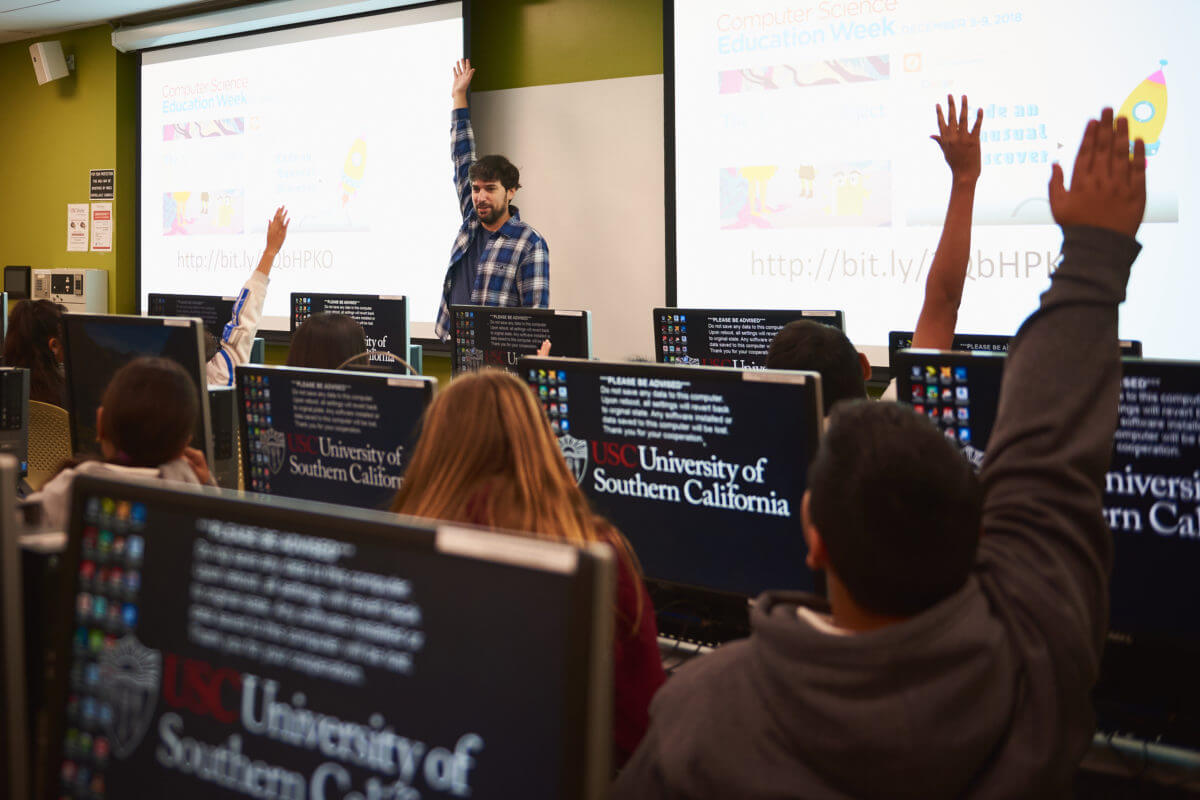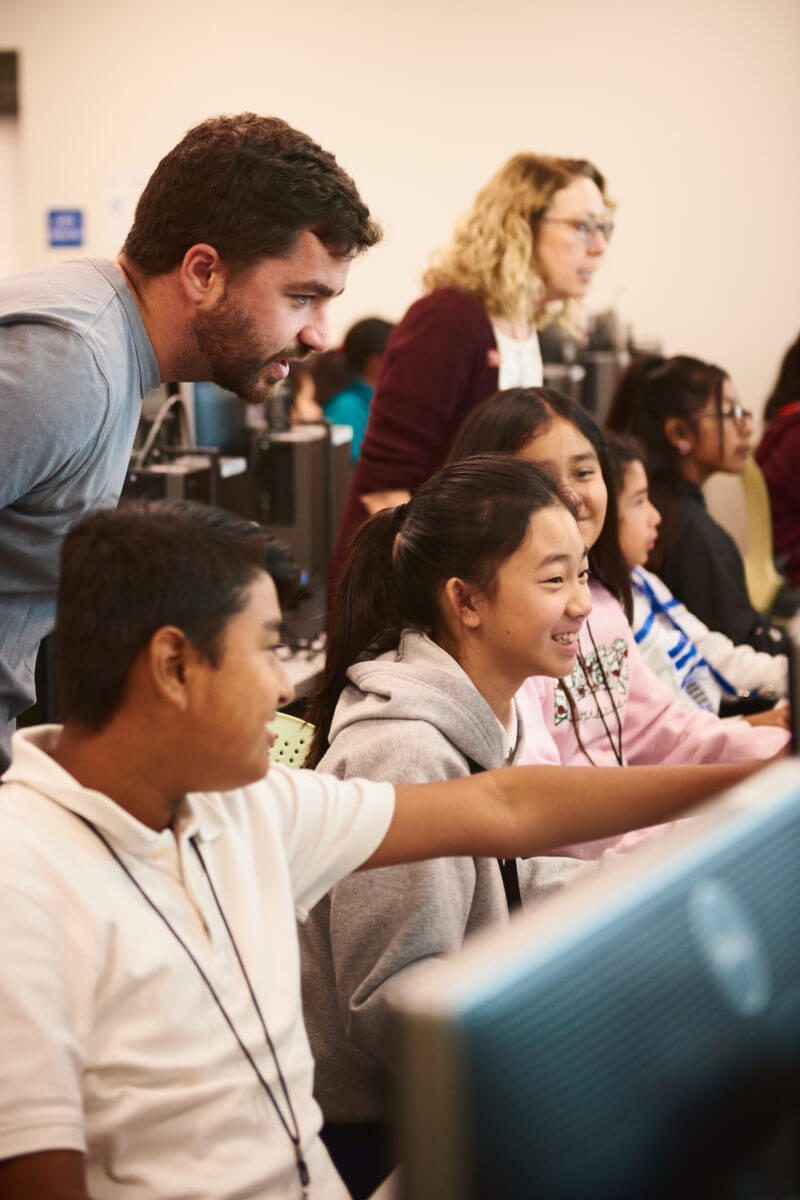Mechanical Engineering student Kendall Work created a song to teach children about angles when programming Sphero SPRK+ robots.
With a clatter of keys and excited whispers, a sixth-grade class of future computer scientists was busily programming interactive animated stories, weaving tales of mythical forest creatures, rocket ships and surprising discoveries.

USC Viterbi School of Engineering VAST student volunteers mentored the students throughout the day. Photo: Joseph Nakhost
The group from Florence Nightingale Middle School in Cypress Park visited the USC campus as part of the 2018 Computer Science Education Week, where visiting Google engineers and USC Viterbi School of Engineering students mentored the sixth graders during the Hour of Code event, taking place in over 180 countries around the world.
The USC CS Education Week activities were coordinated by USC’s Viterbi Adopt-a School, Adopt-a-Teacher (VAST) outreach program to improve STEM pathways for students from under-represented minorities.
As part of the Hour of Code activity, the sixth graders took part in a programming exercise using Scratch, an introductory programming language designed for children that allows them to create simple interactive media such as stories, games and animations. Many of the fundamental skills learned via Scratch can be applied to more advanced languages such as Python.
Storytelling with code

Google engineer Daniel Figueira teaching the Nightingale Middle School students. Photo: Joseph Nakhost
The class was asked to program a short interactive story called “An Unusual Discovery” created for Hour of Code by Google’s CS First team. The activity let students select from a variety of environments in which two animated characters, or “sprites,” make an unexpected discovery. The sixth-graders’ creative programs featured everything from centaurs to dolphins.
One such student, Georgina Paz programmed a story in which a girl discovers flying sneakers that allow her to achieve her basketball dreams. She said she was excited to come to USC to take part in the Hour of Code, and that while she hoped to become a nurse after she finishes school, coding was a great skill to have.

Google’s Max Mujica works with the Nightingale students. Photo: Joseph Nakhost.
Max Mujica, Prabir Pradhan and Daniel Figueira were among the Google engineers on hand to mentor the sixth graders as they explored the possibilities of the Scratch programming language. Mujica said they had been particularly impressed with how quickly and easily the Nightingale students had taken to the coding challenge.
“Everyone’s super creative,” said Mujica, “and all the time they are coming up with their own ideas. They’re not just following the instructions; they’re doing their own thing, which is an important part of coding. To be able to use it as a creative outlet, as well as something functional.”
Figueira said that events like the Hour of Code allowed elementary and middle school students to gain confidence in computing and to explore the fun and creative aspects of programming.
“Scratch is pretty sophisticated and covers a lot of the meat of actual programming in a simplified way,” Figueira said.
“You can make games, you can make animation. It’s about introducing them to these basic concepts so that down the road, they can learn Python, Java and real CS,” Mujica said.
Mentoring future talent
“The biggest take from an event like this is really just being able to talk to the volunteers, being able to come on campus at USC, being here in a computer lab, surrounded by students. On top of that, to have people from Google helping them. I can’t replicate that,” Jorge Reyes said.
Nightingale Middle School teacher Jorge Reyes said his sixth-grade class has a background in Scratch programming and they had already developed a portfolio of projects. He said the students would go on to learn Arduino and Python in seventh and eighth grade.
Reyes said it was valuable for his class to take part in an event like the Hour of Code at USC, and that it was particularly important for the children to see the diversity of the USC computer science students.
Meanwhile, the USC VAST team also reached out to over 500 students throughout the Southland during the virtual part of the Hour of Code outreach. Another Google engineer, Scott Wu, participated alongside the USC Viterbi students. During this two-day “Code Dojo” project, a dozen USC Viterbi Computer Science students called out to 19 classes to video chat and answer the younger students’ questions about coding and college life. Two of those classrooms were involved in USC VAST’s robotics program, which is where USC Viterbi student Kendall Work mentors teachers monthly as they introduce robotics to their first- and second-grade students at three elementary schools in Boyle Heights.
The next day at the STEM Academy of Boyle Heights, VAST co-hosted a hackathon for 60 high school students, in an event supported by will.i.am of The Black Eyed Peas. The artist launched his i.am.angel Foundation in the neighborhood where he grew up and works actively as an advocate for STEM education. The STEM Academy class used Scratch to program avatars to dance to will.i.am’s hit, “I Like to Move It.” Code.org’s Dance Party activity for the week included 32 songs by popular artists including will.i.am, Outkast, Katy Perry, and Selena Gomez.
Throughout the Computer Science Education Week, over 600 students enjoyed the wide variety of Google CS First and Code.org activities supported by USC VAST’s student volunteers. The activities can be accessed any time, not just during this high intensity week, so everyone has a chance to explore this key skill set for the 21st Century.
Published on December 10th, 2018
Last updated on May 16th, 2024







